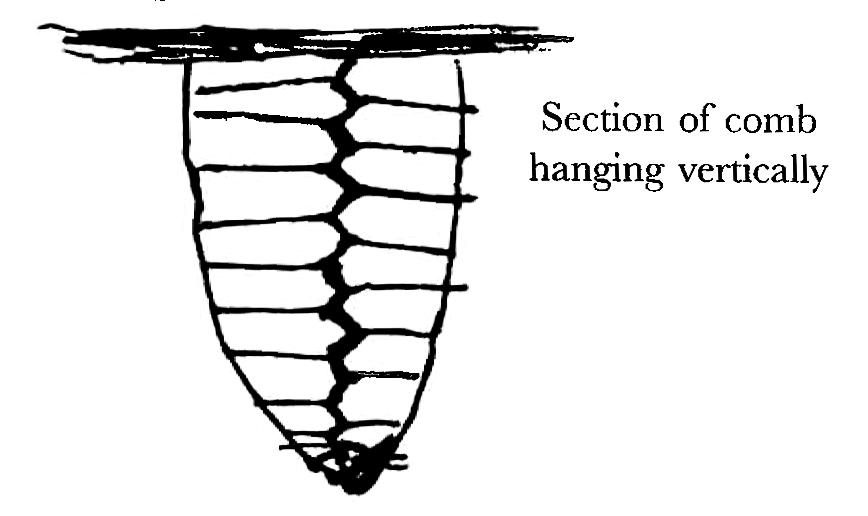To W. H. Miller 1 December [1860]1
Down Bromley Kent
Dec 1
Dear Miller
Some months ago you were so kind as to say you would measure the thickness of the walls of the basal and side plates of the cell of Bee.2 Could you find time to do so soon? Why I want it soon, is that I have lately heard from Murray that he sold at his sale far more copies than he has of the Origin of Species, and that I must immediately prepare a new Edition, which I am now correcting. By the way I hear from Murray that all the attacks heaped on my book do not seem to have at all injured the sale, which will make poor dear old Sedgwick groan.3 If the basal plates and walls do differ considerably in thickness, as they certainly did in the one or two cells which I measured without particular care (as I never thought the point of any importance) will you tell me the bearing of the fact as simply as you can, for the chance of one so stupid as I am in geometry being able to understand.
Would the greater thickness of the basal plates and of the rims of the hexagons be a good adaptation to carry the vertical weight of the cells filled with honey and supporting clusters of living Bees?
Will you endeavour to screw out time and grant me this favour.
Believe me | Dear Miller | Yours sincerely | Ch Darwin
P.S | If the result of your measurement of the thickness of the walls turns out at all what I have asserted; would it not be worth while to write a little bit of a paper on the subject of your former note; and “pluck” the Bees if they deserve this degradation.4 Many mathematicians seem to have thought the subject worthy of attention. When the cells are full of honey and hang vertically they have to support a great weight, can the thicker basal plates be a contrivance to give strength to the whole comb, with less consumption of wax, than if all the sides of the hexagons were thickened?
This crude notion formerly crossed my mind; but of course it is beyond me even to conjecture how the case would be.—5

A mathematician Mr Wright has been writing on the geometry of Bees-cells in the U. States in consequence of my Book; but I can hardly understand his paper6
Footnotes
Bibliography
Correspondence: The correspondence of Charles Darwin. Edited by Frederick Burkhardt et al. 29 vols to date. Cambridge: Cambridge University Press. 1985–.
OED: The Oxford English dictionary. Being a corrected re-issue with an introduction, supplement and bibliography of a new English dictionary. Edited by James A. H. Murray, et al. 12 vols. and supplement. Oxford: Clarendon Press. 1970. A supplement to the Oxford English dictionary. 4 vols. Edited by R. W. Burchfield. Oxford: Clarendon Press. 1972–86. The Oxford English dictionary. 2d edition. 20 vols. Prepared by J. A. Simpson and E. S. C. Weiner. Oxford: Clarendon Press. 1989. Oxford English dictionary additional series. 3 vols. Edited by John Simpson et al. Oxford: Clarendon Press. 1993–7.
Origin 3d ed.: On the origin of species by means of natural selection, or the preservation of favoured races in the struggle for life. 3d edition, with additions and corrections. By Charles Darwin. London: John Murray. 1861.
Origin: On the origin of species by means of natural selection, or the preservation of favoured races in the struggle for life. By Charles Darwin. London: John Murray. 1859.
Summary
Must prepare new edition of Origin.
Discusses structure of beehives. Mentions writings of Chauncey Wright on bees’ cells ["Remarks on the architecture of bees", Proc. Am. Acad. Arts & Sci. 4 (1857–60): 432–3].
Letter details
- Letter no.
- DCP-LETT-2564
- From
- Charles Robert Darwin
- To
- William Hallowes Miller
- Sent from
- Ilkley Down letterhead
- Source of text
- DAR 146: 367
- Physical description
- C 3pp
Please cite as
Darwin Correspondence Project, “Letter no. 2564,” accessed on 27 November 2024, https://www.darwinproject.ac.uk/letter/?docId=letters/DCP-LETT-2564.xml
Also published in The Correspondence of Charles Darwin, vol. 8


